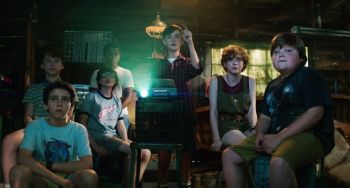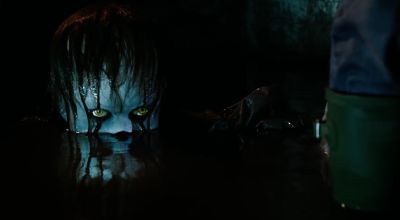By Christopher Sharrett.
I have never much admired the horror fiction of Stephen King, which I’ve called the “hoagie sandwich” approach to the genre, with numerous conventions, images, and devices of horror packed into each novel. Salem’s Lot has the Terrible House with its monstrous history, the serial killer/pedophile, the Cursed Town, and finally a vampire and his emissary. King’s books are overwhelmed with pop culture allusions, usually from King’s boyhood and adolescence in the Fifties and Sixties. His long novels become tedious, as basic ideas are soon exhausted, the plots predictable. He has sold trillions of copies of his books, of course, so concerns at this point seem irrelevant.
IT is King’s mammoth, 1100-page 1986 opus that includes nearly every monster imaginable, if only by allusion, and attempts H.P. Lovecraft’s cosmic horror (the film adaptation of King’s The Mist is one of the best renderings of Lovecraft’s worldview, although it combines it with The Birds and features a cop-out ending), with a vision of a black universe of ineffable dread descending on a circle of outcast children in the town of Derry, Maine in the Fifties. I confess that the book was a hard slog for me. I have no problem with lengthy novels like Daniel Deronda or Little Dorrit, but It, with its long passages about a terrible turtle, can be a trial. The book was adapted for a 1990 TV mini-series, and today a film directed by Andy Muschietti.
 A group of kids who self-identify as the “Losers Club” (since they are their school’s “nerds,” preyed upon by bullies for their shyness flowing from intellects that place them above their peers) are set upon by an evil clown named Pennywise (I’m surprised he doesn’t have a partner named Pound Foolish) who can incarnate each child’s deepest fear. The novel and TV adaptation included a narrative dealing with the kids in adulthood, as they team together once again to face a newly incarnated Pennywise, and their anxieties as adults (this part of the book is being saved for the movie’s sequel that will necessarily ruin King’s apparent purpose). Their team includes and African-American boy (then man) and a girl named Beverly who proves the most mature of the Losers. The inclusion of an African-American boy in a white group in Fifties small-town Maine (the movie relocates the story to the Eighties) seems a good-hearted gesture that in fact would be unlikely, more so even than a girl joining a boy’s club, given how our society segregates the sexes before puberty.
A group of kids who self-identify as the “Losers Club” (since they are their school’s “nerds,” preyed upon by bullies for their shyness flowing from intellects that place them above their peers) are set upon by an evil clown named Pennywise (I’m surprised he doesn’t have a partner named Pound Foolish) who can incarnate each child’s deepest fear. The novel and TV adaptation included a narrative dealing with the kids in adulthood, as they team together once again to face a newly incarnated Pennywise, and their anxieties as adults (this part of the book is being saved for the movie’s sequel that will necessarily ruin King’s apparent purpose). Their team includes and African-American boy (then man) and a girl named Beverly who proves the most mature of the Losers. The inclusion of an African-American boy in a white group in Fifties small-town Maine (the movie relocates the story to the Eighties) seems a good-hearted gesture that in fact would be unlikely, more so even than a girl joining a boy’s club, given how our society segregates the sexes before puberty.
Derry is another Cursed Town, but the reason for the curse is obscure both in the TV and theatrical adaptations. We learn of murders and other foul deeds, but what is the rhyme and reason? The book is explicit: the town has a white supremacist organization that has engaged in lynching blacks over its history, and has tolerated the abuse and murder of the young. The novel’s Peyton Place element is its strongest suit, true also of Salem’s Lot – I don’t mean this derisively, since Peyton Place has been undervalued, with reviewers and the public missing the rage of author Grace Metalious, focusing instead on “sex scenes” that are practically non-existent, certainly as masturbation aids.
 King’s virtue is his focus on the lives of children, but he depends too much on monsters to exteriorize the terrors faced by kids. At times his monsters look merely opportunistic; Pennywise seems to capitalize on the Killer Klown fad that overtook Heavy Metal and numerous forms of pop culture in the last thirty years; the idea that clowns are repulsive dates at least to commedia dell’arte (we need to thank Mikita Brottman for her important scholarship). In IT, the suffering of children is grounded only somewhat in everyday miseries. Beverly is sexually abused by her father, although he is rendered in the new film with somewhat gothic presentation, making him one outlandish beast among many. There is an extraordinary scene in the novel that has no correlate in the film: as the kids try to find their way through the maze of a haunted sewer, Beverly invites the boys to have sex with her as a calmative tonic. The scene portrays all the kids as unknowing and tentative (even the more self-knowing Beverly) in their awakened pubescence. It is a touching moment ignored in the film, preferring to stick with the pointless, unfounded but preferred idea of childhood “innocence.”
King’s virtue is his focus on the lives of children, but he depends too much on monsters to exteriorize the terrors faced by kids. At times his monsters look merely opportunistic; Pennywise seems to capitalize on the Killer Klown fad that overtook Heavy Metal and numerous forms of pop culture in the last thirty years; the idea that clowns are repulsive dates at least to commedia dell’arte (we need to thank Mikita Brottman for her important scholarship). In IT, the suffering of children is grounded only somewhat in everyday miseries. Beverly is sexually abused by her father, although he is rendered in the new film with somewhat gothic presentation, making him one outlandish beast among many. There is an extraordinary scene in the novel that has no correlate in the film: as the kids try to find their way through the maze of a haunted sewer, Beverly invites the boys to have sex with her as a calmative tonic. The scene portrays all the kids as unknowing and tentative (even the more self-knowing Beverly) in their awakened pubescence. It is a touching moment ignored in the film, preferring to stick with the pointless, unfounded but preferred idea of childhood “innocence.”
There are moments of intelligence, such as the film’s look at young bullies, portrayed as young psychopaths created by parental psychopaths, a standard view of the problem.
At some point there will be horror films focusing on the young that will deal in quotidian miseries, like kids being abused on a regular basis, and neglected, coerced, and harassed by the educational system – or simply short-changed by it, since kids commonly leave high school with only scraps of basic knowledge. Do we need monsters to externalize all of these manifest horrors?
Christopher Sharrett is a Contributing Editor of Film International. He is a Professor of Film Studies at Seton Hall University.


Interesting review. Like Robin Wood, I’ve moved on from the horror film to seek more rewarding pastures but still stand by what I’ve written concerning past (and some present) achievements. Your last paragraph suggests fertile territory for exploration but I doubt whether contemporary Hollywood has the courage to do so. In the meantime, we have self-styled expert charlatans championing the latest trivial pursuits in presentations to which they have been invited to by dumb and lazy graduate students whose interests reveal further decline in thbe ideals of higher education championed by Wood, Leavis and others. However, at least we have your work to inform us of this continuing decline.
“quotidian miseries, like kids being abused on a regular basis, and neglected, coerced, and harassed by the educational system” – I’ve often felt that a horror movie based on Dickens’s “Hard Times” would be truly terrifying – and would pay no quarter to what Sharrett astutely describes as “the pointless, unfounded but preferred idea of childhood ‘innocence'” that Stephen King and contemporary Hollywood perpetuate. Perhaps Gaspar Noe would direct.
There have, of course, been adaptations of Hard Times on the BBC, all a bit polite. Dickens’s vision, as horrific and honest as it is, could not stand against an uncompromised rendering of the current educational system in the US. There is NO education, and students are being “prepared” (we have accepted the idea that the school and university process people for private interest, although that project has failed) for work at a fast food store, or the aisles of a big box store, or answering calls at a call center–but each position is being phased out by cybernetics.
Well said, Chris. I feel that Bogart’s final lines at the end of THE HARDER THEY FALL (1956) be changed to “Higher education (rather than boxing) is a racket. It must be abolished.” The huge fees, lifelong student debt, semi-permanent slavery in low-paid jobs, the overwhelming presence of privileged “Downton Abbey” faculty and graduate students who have never worked in low-income jobs in their entire life, Faculty Unions who wholeheartedly support higher administration in the hopes of entering their hallowed ranks and “diss” NTT faculty are all products of this system. If Marx and Engels could write KAPITAL etc, outside a University, (19th Welsh miners read these “difficult texts” with annotations (as the South Wales Miner’s Library shows), and Jack London, James Jones and others become authors without the benefit of universities and creative writing departments, then it is all the more clear that self-education rather than institutional indoctrination represents the way forward.